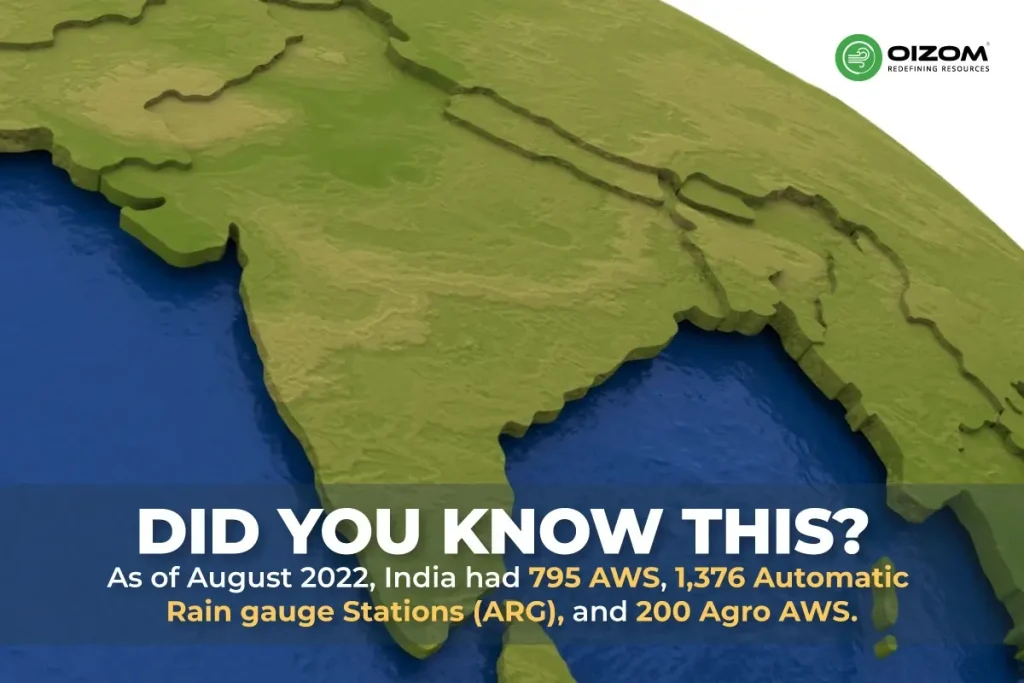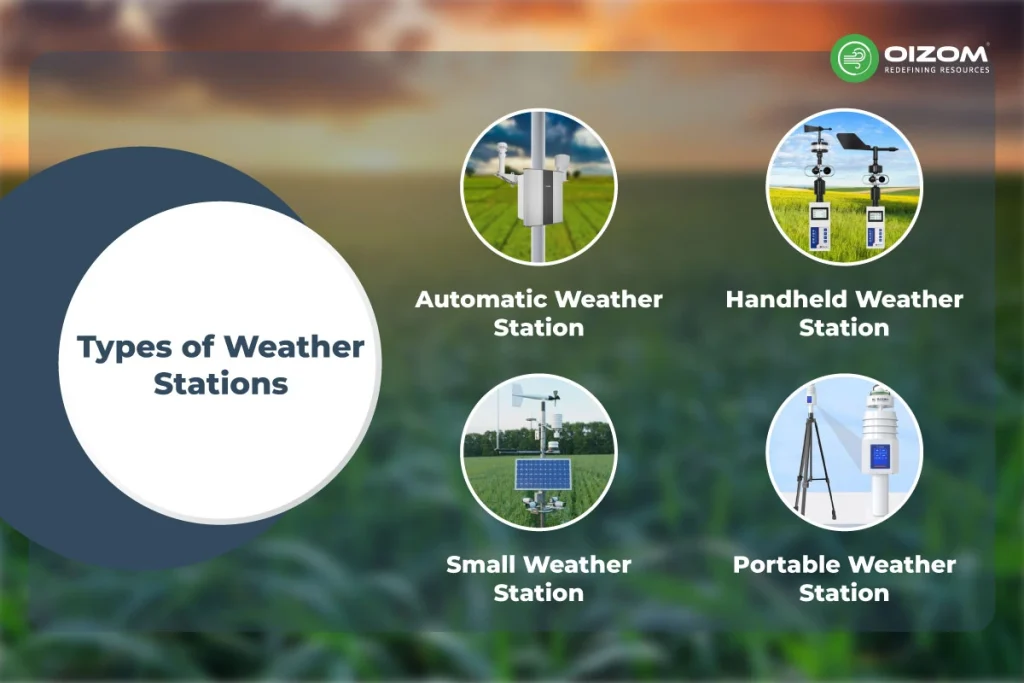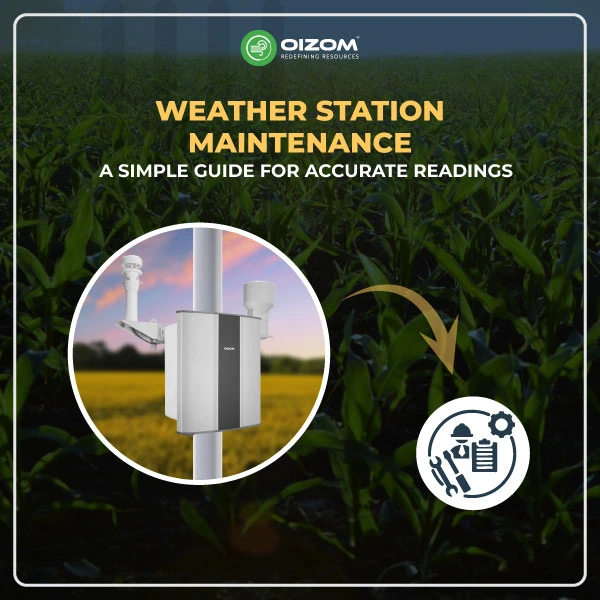10 Key Takeaway Points:
- Importance of Maintenance: Regular maintenance ensures accurate weather data and extends the lifespan of your weather station.
- Weather Station Types: Understand the purpose of various stations, including automatic, handheld, small, and portable models, to choose the right one for your needs.
- Sensor Care: Clean sensors and radiation shields regularly to avoid obstructions like dust or debris that can impact accuracy.
- Power Monitoring: Check power sources like batteries or solar panels frequently to prevent downtime or data loss.
- Data Transmission: Reliable systems like Oizom Weathercom offer internal storage of up to 8 GB, securing data for 90 days in case of transfer issues.
- Display Maintenance: Keep display units clean, check for damages, and replace batteries as needed to ensure smooth operation.
- Troubleshooting Tips: Address common issues like inaccurate readings, connectivity problems, or power interruptions with regular inspections and calibration.
- Tools for Maintenance: Use cleaning kits, calibration tools, replacement parts, and software utilities for efficient upkeep.
- Environmental Impact: Weather stations require specific maintenance schedules depending on their brand, model, and environment.
- Follow Manufacturer Guidelines: Always refer to the user manual for detailed instructions to ensure proper care and optimal performance.
Weather Station Maintenance: A Simple Guide for Accurate Readings
With the progress of science and technology, weather stations are increasingly widely used in many fields, such as agriculture, military, scientific research, and environmental monitoring, and have become an important tool for obtaining real-time weather data. Maintaining a weather station might sound technical, but it’s simpler than you think! Regular upkeep is the key to ensuring your weather station provides accurate and reliable data.

Think of it like taking care of a bike or car, regular check-ups keep things running smoothly. Over time, dirt, dust, and weather can affect the sensors, leading to incorrect readings. But with a few simple steps, you can keep your station working perfectly. This guide will walk you through easy maintenance tips, like cleaning sensors and checking settings, to help you get the best performance from your station. With just a little effort, you’ll keep your weather station accurate and reliable for years to come. Let’s dive in!
Importance of regular weather station maintenance
Weather stations provide users with valuable weather information over the years. To ensure accurate measurements and extend the equipment’s lifespan, regular maintenance is essential. Thankfully, with a consistent schedule, maintenance becomes a simple and manageable task.
Since weather stations operate outdoors year-round, they can be impacted by severe weather. After storms or extreme conditions, it’s a good idea to inspect your station. For instance, check if the anemometer is not damaged and spinning freely, especially during winter. Make sure the rain gauge is free from leaves, bugs, or debris like waste paper. Also, inspect the solar panels for any sand or dirt buildup that could affect their performance.
Caution: Maintenance procedures can vary depending on the brand and model of your weather station. Many sensors and components are built with precision technology, so it’s important to handle them carefully during cleaning and upkeep. For detailed instructions, always refer to the user manual specific to your weather station.
Keep in mind that every weather station is unique. This guide offers general maintenance tips and may not cover the specific requirements of your model. Following the manufacturer’s recommendations will ensure proper care and optimal performance for your device.
Types of Weather Stations

Weather stations can be divided into the following types:
- Automatic Weather Station: Designed for convenience, automatic weather stations can measure multiple meteorological parameters and transmit data remotely. Weather data can be accessed anytime using a computer, mobile phone, or other devices.
- Handheld Weather Station: Ideal for situations where only a few parameters need to be measured and fixed equipment isn’t necessary. Handheld weather stations are portable, easy to use, and perfect for quick, on-the-go weather measurements.
- Small Weather Station: Compact and designed for fixed locations, small weather stations are ideal for monitoring fewer parameters, typically ranging from 4 to 10. They are reliable for 24/7 measurement in applications with moderate data needs.
- Portable Weather Station: Lightweight and mobile, portable weather stations are perfect for users who frequently change locations. They can measure parameters like wind speed and direction, air and soil temperature and humidity, sunlight hours, light intensity, and UV levels. These stations are simple to operate, easy to set up, and suitable for diverse meteorological needs.
Key Components Requiring Maintenance
Maintenance requirements vary among weather stations. The correct routine can help you maintain everything functioning like a well-oiled machine, whether yours is wired or wireless, indoor or outdoor weather monitoring stations. Depending on the brand and model of the weather station, different maintenance procedures will apply. Additionally, some devices might not include all of the individual sensors we discuss, so for precise installation and maintenance instructions, make sure to refer to your user manual.
Sensors
Obstructions like dust, insects, or leaves on the radiation shield can affect temperature and humidity readings.
To clean it:
- Gently dust the radiation shield using a soft cloth or small toothbrush.
- Check your user manual for guidance on removing the radiation shield. Once removed, unstack the panels and clear any debris stuck between them.
- Wash the panels with warm, clean water and ensure they are completely dry before putting them back.
- Carefully clean around the temperature and humidity sensor using a soft cloth or toothbrush.
Regular cleaning will help maintain accurate readings and extend the lifespan of your weather station.
Power Supply
Maintaining the power sources of your weather station sensors is extremely important. Failure to do so will result in an interruption in data collection.
Monitor the Power Supply: Regularly check the power supply of your weather station, whether it uses solar panels or batteries, to ensure it has enough power. This helps prevent data loss or downtime caused by low power. If your equipment uses batteries, replace them regularly to keep the station running smoothly and reliably over the long term. Whether your devices are in an off-grid location or a remote area, you don’t need to worry. Oizom Weathercom can run fully on solar power, ensuring uninterrupted operation.
Data Transmission Systems
Data transmission and storage: Real-time transfer of meteorological data to server rooms for processing and archiving is necessary. However, there are several obstacles in the way. For instance, storage devices may be defective or destroyed, and data may be lost or inaccurate during transfer. Say goodbye to data worries with Oizom Weathercom. It addresses these concerns with its internal storage capacity of up to 8 GB, allowing secure storage of data for up to 90 days. This ensures reliable data backup even in case of transmission issues, offering uninterrupted insights and peace of mind.
Display Units
Display units are essential for viewing real-time weather data, so regular maintenance is important. Clean the screen with a soft cloth to remove dust and smudges. Check for any damage to the screen or its casing. Ensure the display is properly connected to the weather station to avoid data errors. If it uses batteries, replace them when needed to keep it working smoothly. Always follow the manufacturer’s instructions for cleaning and care to keep the display reliable and accurate for monitoring.
Common Issues and Troubleshooting Tips
Weather stations can face common issues like inaccurate readings, connectivity problems, or power interruptions. Here are quick troubleshooting tips to keep your device running smoothly:
- Inaccurate Readings: Check if the sensors are clean and free from dust, debris, or obstructions. Recalibrate the sensors if required, following the user manual.
- Connectivity Problems: Ensure all cables are securely connected, and check the network or signal strength for wireless models. Restart the device if necessary.
- Power Interruptions: For battery-powered stations, replace old batteries. If using solar panels, clean them regularly to maintain efficiency.
- Data Loss: Use devices with internal storage, like Oizom Weathercom, to ensure a backup in case of transmission issues.
Tools and Equipment for Maintenance
When it comes to cleaning your weather station, using the right set of tools is essential. Here’s a list of items you should have on hand. Have a quick overview of essentials:
Cleaning Kits
Dust and debris can affect sensor accuracy. Use a soft cloth, small brushes, or air blowers to clean sensors, radiation shields, and other components. Avoid abrasive materials to prevent damage.
Calibration Tools
For accurate readings, periodic calibration is crucial. Use calibration kits or tools provided by the manufacturer to fine-tune your sensors. Always follow the user manual for precise calibration procedures.
Replacement Parts
Weather stations exposed to bad conditions may need parts replaced over time. Stock up on commonly required replacements like batteries, sensors, or mounting brackets to minimize downtime.
Software Utilities
Some weather stations come with software for diagnostics and updates. Use these utilities to check device health, troubleshoot issues, or update firmware for optimal performance.
Having these tools on hand ensures your weather station remains accurate and reliable. Regular maintenance using the right equipment will extend its lifespan and keep it running smoothly, providing consistent weather data. Always refer to the manufacturer’s guidelines for recommended tools and processes.
Conclusion
In conclusion, maintaining your weather station is easy and important. Regular maintaining extends the life of your device and ensures accurate readings, helping you get the most out of your investment. Each weather station has unique maintenance needs, influenced by its brand, model, and environment. By following proper care routines and the manufacturer’s guidelines, you’ll improve your understanding of its sensors and ensure reliable performance for years to come. A well-maintained weather station is key to consistent, precise weather data, making your efforts well worth it.






